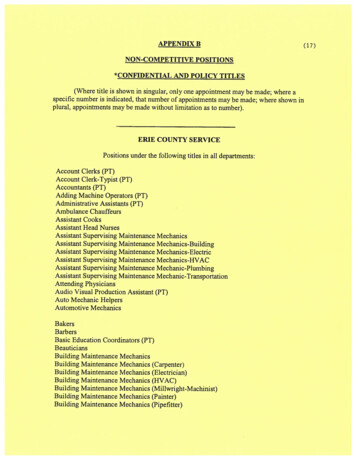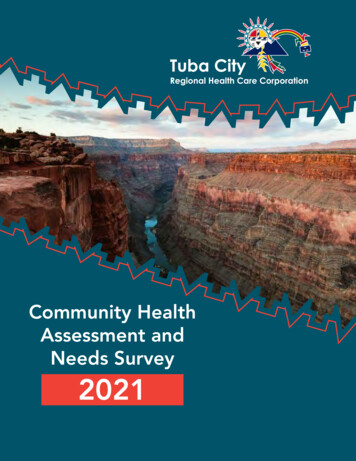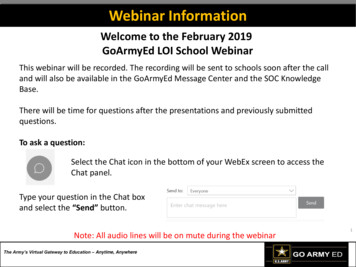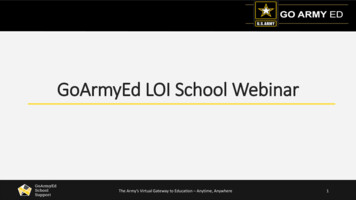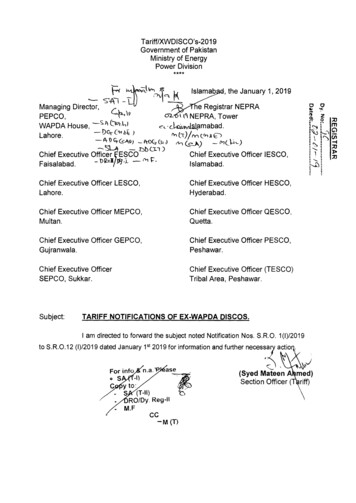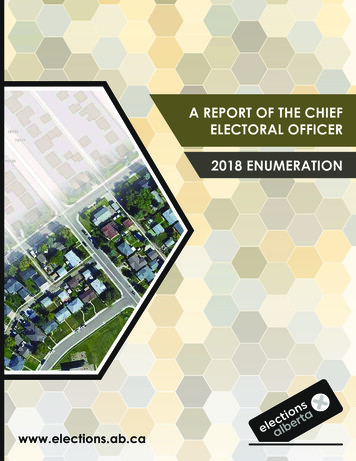
Transcription
A REPORT OF THE CHIEFELECTORAL OFFICER2018 ENUMERATIONwww.elections.ab.ca
October 10, 2019Mr. Mike Ellis, ChairStanding Committee on Legislative Offices6th Floor, Federal Building9820 – 107 StreetEdmonton, Alberta T5K 1E7Dear Mr. Ellis:I have the honour and privilege to submit the Report of the Chief Electoral Officer on the 2018Provincial General Enumeration in accordance with the provisions of section 21(4) of theElection Act.Should you require additional information or clarification on anything contained in the Report,I would be pleased to respond.Sincerely,Glen Resler, CPA, CMAChief Electoral Officer
Table of ContentsRemarks of the Chief Electoral Officer. 5Section 1 - Enumeration . 7Overview / Purpose . 9Appointment of Returning Officers . 12Timeline. 15Technology . 19Public Information and Communications . 21Enumerator Recruitment and Training . 24Strategies and Methods . 25Results . 28Challenges . 34Section 2 - Finance . 41Financial . 43Section 3 - Recommendations . 51Recommendations . 53Section 4 - Appendices . 57Appendix A: Electoral Division Results . 59Appendix B: Demographics of the Register of Electors . 81Appendix C: Maps . 96
Remarks of the Chief Electoral OfficerFollowing the 2015 General Election, my Office undertook a review ofAlberta’s permanent Register of Electors. Staff spent significant timeinputting data from electoral documents and removing duplicate andincomplete records. My Office also kept up its continuous processing ofupdates from public data sources into the register between electoralevents.This work prepared us for the 2016-17 Alberta Electoral BoundariesCommission. After announcement of the new electoral boundaries,every household address and all associated electors needed to bemoved into their new electoral division. Having an accurate register andup-to-date elector information greatly improved redistribution and listaccuracy.The conduct of a full door-to-door provincial enumeration was notoriginally scheduled prior to the 2019 Provincial General Election.In consideration of the significant efforts already undertaken on theRegister and the known challenges from previous enumerations, I intended that a targeted enumeration becompleted instead. The targeted enumeration would have focused on areas with new growth and areas ofunder-representation.However, under the authority of Bill 32: An Act to Strengthen and Protect Democracy in Alberta, my Office wasmandated to complete a full provincial door-to-door enumeration within the year. The Office successfullyexecuted this mandate, while also working to complete the update to all polling subdivision boundaries requiredfor the newly approved electoral boundaries, conducting two by-elections, and preparing for the 2019 ProvincialGeneral Election.I would not have been able to conduct these events successfully without the help and support of a strong teamof dedicated professionals at Elections Alberta.Further, I am grateful for all the hard work and countless hours put in by the 87 returning officers and their staffto deliver a successful enumeration. Most of these returning officers were recruited when there was not arequirement for a full enumeration. I deeply appreciate the commitment these officers had to their positions,and am grateful they were able to rearrange their schedules to support my Office, their individual electoraldivisions, and this mandate.I additionally appreciate the efforts and time put in by our partner agencies. With our tight timelines and highexpectations, these agencies were also required to go above and beyond. Many put in extensive hours to deliverthe enumeration in addition to preparing for the Provincial General Election.Page 7
Lastly, I must acknowledge the thousands of Albertans who took on the enumerator’s role, braved cold weather,and worked through significant challenges to serve their neighbours and ensure that as many as possible wereregistered to vote in advance of the General Election.Five recommendations are attached to this report; the most important is to eliminate the requirement formandatory door-to-door enumerations prior to Provincial General Elections. Although the 2018 ProvincialEnumeration was successfully delivered, it required a significant investment of money, time and staffingresources, without an associated significant increase in the quality of the Register of Electors. I would like to seemy Office focused on finding new means of elector engagement to increase registration of underrepresentedareas, and to ensure we are fiscally responsible within our mandate.I am therefore pleased to submit this report on the 2018 Provincial Enumeration.Glen ReslerChief Electoral OfficerPage 8
ENUMERATIONPage 9
Overview / PurposeAn enumeration was conducted in the fall of 2018 to update the Register of Electors. The Register of Electors isan electronic database containing both elector information and information on each elector’s correspondingphysical address. This is a continuously updated database used to prepare Lists of Electors, which are requiredfor electoral events. The Register of Electors was originally established in 1996 and has been updated since the2001 Provincial General Election through elector-initiated requests, enumeration activities and use ofinformation provided by various public agencies, in accordance with Sections 13.1 and 13.2 of the Election Act.The public agencies that provide data for use in updating the Register of Electors include: Elections Canada, which provides data from the National Register of Electors, including updates fromthe Canada Revenue Agency (income tax returns), Citizenship and Immigration and Canada Post’sNational Change of Address files; Service Alberta, which provides address updates for registered electors who hold Alberta Driver’sLicences and Alberta Identification Cards, as well as vital statistics data to facilitate the deletion ofdeceased electors; Alberta Health, which provides address updates for registered electors covered by the Alberta HealthInsurance Plan; Alberta Education, which provides information on 16- and 17-year-olds to be included as future votersin the Register of Electors; Alberta Health Services (Emergency Medical Services), which provides information on addresses andtheir associated longitude and latitude (XY) coordinates; and Alberta municipalities, which provides addressing, geographic information system (GIS) mapping, andlongitude and latitude (XY) coordinates for addresses within their municipality.These updates are complemented by data collected through Voterlink (voterlink.ab.ca), our secure online voterregistration system, which allows electors to add or update their own information. Voterlink is availablebetween all electoral events. It is also used to support revisions to elector information prior to a by-election orgeneral election.The Register of Electors can also be updated through enumeration activities, which most recently occurredbetween August 1 and October 12, 2018 under the authority of Section 13.1(2)(a) of the Election Act.Through the provincial enumeration we aimed to reach as many electors as possible to confirm, add or updatetheir information to the Register of Electors. We did this by complementing door-to-door visits with an onlineand telephone enumeration option, as well as providing alternative enumeration options for First Nationscommunities, Métis Settlements, supportive living facilities, long-term care facilities and Hutterite colonies.Page 11
Figure 1: Options for completing enumerationThrough enumeration, information was gathered on both electors and future voters for the Register of Electors.Individuals who are Canadian Citizens, at least 18 years of age, and ordinarily resident in Alberta are consideredelectors.Individuals who are 16- or 17-years of age, Canadian Citizens, and ordinary residents in Alberta, are consideredfuture voters. They are added to the List of Electors only when they turn 18. The 2018 Provincial Enumerationwas the first time that information was collected on future voters.Figure 2: Eligibility criteria for inclusion on the Register of ElectorsPage 12
Maintaining an accurate Register of Electors is essential to electoral administration, as it: Reduces the time required for an elector to vote by eliminating the need to complete additionalpaperwork at the polls prior to being provided a ballot; Allows for the mail-out of ‘Where to Vote’ cards to individual electors, to provide each with specificinformation such as polling place locations; Allows Elections Alberta and the returning officers of each electoral division to plan ballot counts,staffing numbers and polling place locations; and Removes a barrier to voting by maintaining elector registrations between events.The ongoing accuracy of the Register of Electors is challenging to measure, as the number of persons that meetthe eligibility requirements is not tallied in any other way. Instead, the following measures are used as anindicator of the quality and accuracy of the Register of Electors: A comparison to the most recent Canada Census and Alberta Treasury Board and Finance populationnumbers, taking into account eligibility factors (age and citizenship); The percentage of electors that register at the polling place to vote, either as new electors or asprevious electors who have moved to a new residential address; and The percentage of electors on the Register of Electors that have been data matched to an AlbertaDriver’s Licence or Identification Card. Electors that have been data matched will automatically havetheir address information updated in the register when they move and update their licenceinformation.Page 13
Appointment of Returning OfficersThe Chief Electoral Officer appointed returning officers under Section 9 of the Election Act. These returningofficers were hired for the province’s 87 electoral divisions through open, merit-based competitions heldbetween October 2017 and July 2018.Electoral DivisionReturning Officer01 – Calgary-AcadiaDavid McIntyre02 – Calgary-BeddingtonAnneMarie Darichuk03 – Calgary-BowSusan McMahon04 – Calgary-BuffaloKevin Allen05 – Calgary-CrossWally Clarke06 – Calgary-CurrieLinda Garrett07 – Calgary-EastLe-Ann Lundgren08 – Calgary-EdgemontMerilyn O'Bryan09 – Calgary-ElbowFiona MacGregor10 – Calgary-FalconridgeGrant Shewchuk11 – Calgary-Fish CreekShauna Hunter12 – Calgary-FoothillsB. Lynne Hodgson13 – Calgary-GlenmoreElizabeth Evans14 – Calgary-HaysCatherine Misener15 – Calgary-KleinMarion Owen16 – Calgary-LougheedHuntley O'Neill17 – Calgary-McCallBob Hogarth18 – Calgary-Mountain ViewSean McLennan19 – Calgary-NorthDezreen Mills20 – Calgary-North EastSharon Jensen21 – Calgary-North WestRuth Sorrentino22 – Calgary-PeiganJackie Nixon23 – Calgary-ShawIlene Burns24 – Calgary-South EastDonna McWilliams25 – Calgary-VarsityMadeline J. Wood26 – Calgary-WestCurtis Lawson27 – Edmonton-Beverly-ClareviewAngela Zenowski28 – Edmonton-Castle DownsChris GelinasPage 14
Electoral DivisionReturning Officer29 – Edmonton-City CentreWilliam Dolman30 – Edmonton-DecoreBill Maxim31 – Edmonton-EllerslieWard Baskett32 – Edmonton-GlenoraKim Davis33 – Edmonton-Gold BarLeslie Silver34 – Edmonton-Highlands-NorwoodAnne Hill35 – Edmonton-ManningNada Gebara36 – Edmonton-McClungEldon Okrainetz37 – Edmonton-MeadowsDanny Kinal38 – Edmonton-Mill WoodsBrian Dompé39 – Edmonton-North WestWalter Szwender40 – Edmonton-RiverviewGunnar Blodgett41 – Edmonton-RutherfordElse Marie Smart42 – Edmonton-SouthColette Williams43 – Edmonton-South WestWendy E. Campbell44 – Edmonton-StrathconaKathleen Hopkins45 – Edmonton-West HendayMarcia McKall46 – Edmonton-WhitemudBarbara Willman47 – Airdrie-CochraneLorraine Romain48 – Airdrie-EastJean Kruse49 – Athabasca-Barrhead-WestlockLorrill Waschuk50 – Banff-KananaskisShirley Kine51 – Bonnyville-Cold Lake-St. PaulBrenda Parsons52 – Brooks-Medicine HatDaphne Anstey-Martin53 – CamroseMichael J. Smith54 – Cardston-SiksikaDawna Fiesel55 – Central Peace-NotleyJan Meston56 – Chestermere-StrathmoreWhitney Zemp57 – Cypress-Medicine HatAllan Bloomfield58 – Drayton Valley-DevonSandi Dahl59 – Drumheller-StettlerJanice Hoover60 – Fort McMurray-Lac La BicheSherry Campbell61 – Fort McMurray-Wood BuffaloElections Alberta Head OfficePage 15
Electoral DivisionReturning Officer62 – Fort Saskatchewan-VegrevilleHoward Huston63 – Grande PrairieW. J. Keith Spencer64 – Grande Prairie-WapitiMargaret (Marge) Seweryn65 – HighwoodBrenda Honish66 – Innisfail-Sylvan LakeCarla Gabert67 – Lac Ste. Anne-ParklandReanne Kronewitt68 – Lacombe-PonokaMargaret DeVries69 – Leduc-BeaumontEugene Miller70 – Lesser Slave LakeCandace Callioux71 – Lethbridge-EastDonna Murray72 – Lethbridge-WestAshley Haughton73 – Livingstone-MacleodBlanche Schellenberg74 – Maskwacis-WetaskiwinCaroline Dillabough75 – Morinville-St. AlbertJulius Buski76 – Olds-Didsbury-Three HillsLaura Ewert77 – Peace RiverDawn Coulas78 – Red Deer-NorthFred Gorman79 – Red Deer-SouthJim Taylor80 – Rimbey-Rocky Mountain House-SundreJane E. Henderson81 – Sherwood ParkMelody Yates82 – Spruce Grove-Stony PlainCindy Petherbridge83 – St. AlbertKathie Zalasky84 – Strathcona-Sherwood ParkDarcy Gurski85 – Taber-WarnerStella Lukinski86 – Vermilion-Lloydminster-WainwrightJohn Erkelens87 – West YellowheadCatie KoppPage 16
TimelinePreparation of Electoral Divisions and Polling Subdivisions for EnumerationThe timeline for commencement of the enumeration event was heavily affected by the workload associatedwith implementing the new electoral boundaries, as approved by the Legislative Assembly in December 2017.While the amended boundaries did not come into effect until the writ was issued for the 2019 Provincial GeneralElection, the enumeration was conducted utilizing the new boundaries to support the creation of the List ofElectors for the election.Returning officers were engaged starting in the fall of2017 and continuing into summer 2018 to establish6,751 polling subdivision boundaries to bestaccommodate accessibility, geography, distance,travel time and polling place availability.Then, all returning officers were provided with theirelectoral lists for review. This process entailed eachreturning officer checking and verifying that eachknown address was correctly associated to the rightpolling subdivision.Our review of electoral maps and address listsconcluded in June 2018. Owing to the timing of theenumeration, not all address updates could be madeprior to the start of the enumeration period.Enumeration Preparation and TrainingCoinciding with the review and update of the electoral maps and lists, planning and preparation for theenumeration was also well underway early in 2018. This work included preparing system requirements for thedevelopment of a software application needed to support enumeration activities, and the development andordering of enumeration forms and materials. Assembling and packing the necessary enumeration supplies forshipment to each returning officer began at the beginning of July. All supplies were received in the ElectionsAlberta warehouse by the end of July for early August delivery to each returning officer’s home office.The development of an enumeration process and a full training package for enumerators was also completedon a short timeline. Training for returning officers was completed in June and July 2018, as their role in theenumeration commenced in July with the recruitment of enumerators. Returning officers received two full daysof training in preparation for the conduct of the enumeration in each of the 87 electoral divisions.Page 17
Figure 3: Enumeration supply shipments in the Elections Alberta warehouseRecruitmentThe recruitment of enumerators commenced in July 2018, with an advertising campaign focused on drivingapplicants to our jobs website. More than 9,000 people applied to work as enumerators. Urban areas receivedthe majority of the online applicants. Many returning officers outside urban areas needed to undertakeadditional recruitment activities. They reached out to local service agencies, social clubs, community groups,employee associations, religious organizations, and staff from previous electoral events.Training for enumerators was provided by the returning officers throughout August and the beginning ofSeptember. Each enumerator was provided with four hours of training prior to commencing their duties.Self-EnumerationWhile returning officers were undertaking recruitment and training activities, Elections Alberta launched aprovincial Call Centre and enumeration website on August 1, 2018. The website was intended to provideAlbertans with the opportunity to complete their enumeration over the phone or online in lieu of receiving avisit from an enumerator. Advertising was undertaken to notify people of the self-enumeration option. Morethan 50,000 households completed their enumeration using one of the self-enumeration options during themonth of August.Page 18
Door-to-Door EnumerationOn September 8, 2018, door-to-door enumeration activities commenced throughout the province. Enumeratorscollected information from over 800,000 households between September 8 and October 5, 2018. Wherepossible, three visits were made to attempt to reach the household and collect information. On each visit, a ‘WeMissed You’ card was left for the household to be able to complete their enumeration online or over the phone.Figure 4: We Missed You CardElectors who were missed during the enumeration had additional opportunities to be added to the Register ofElectors. They were able to complete self-enumeration through the website or Call Centre until October 12,2018. After that date, the enumeration service was closed, but the Voterlink website reopened for electors toupdate their information.Payment ProcessingFollowing completion of door-to-door activities, Elections Alberta began processing fee and expense paymentsfor the 5,692 enumerators, 110 support staff, and 87 returning officers responsible for completing theenumeration. Challenges were experienced with delivery of enumerator pay cheques through the mail systembecause of a rotating Canada Post strike in October, when the pay cheques were processed.Page 19
Data EntryData entry and the import of updated elector information into the register of electors commenced immediatelyfollowing the conclusion of the enumeration. Following the integration of available updates, Lists of Electorswere provided to registered political parties, in accordance with section 18(1)(b) of the Election Act. Lists ofElectors were made available on February 1, 2019 at the start of the campaign period for the 2019 ProvincialGeneral Election.Page 20
TechnologyA computer application was adopted in order to give electors multiple methods by which to complete theirenumeration. Other new applications let enumerators be aware of which households completed selfenumeration, and allowed enumerators to use computer tablets to collect elector data. In previous enumerationevents, all data was collected manually on paper forms. New technology was adopted for several reasons: Enumerators could be supported by a centralized Call Centre for elector call backs and questions; More monitoring could be completed of enumerator work plans and whereabouts for health andsafety compliance; Elector data could be maintained in a secure manner, reducing the potential for loss or misuse of data;and Required data entry could be reduced.Figure 5: Tablet and enumerator applicationPage 21
Deploying a new application in such a short window of time posed a major challenge. A web-based applicationwas developed by a third-party vendor and it supported the three methods of enumeration: An online application allowed electors to verify or update the information for their household.This application could be used only by individuals with an Alberta Driver’s Licence or IdentificationCard, as the information from the card was used to verify the identity of the person providinginformation. A Call Centre application allowed Call Centre operators to see information on all households in theprovince, including visit status and electors already in the register. Seeing this information allowedthem to update or confirm information provided by the caller. An application accessed on each enumerator’s tablet connected to a cellular network that allowed theenumerator’s access only to the polling subdivisions that they were assigned. The application allowedaccess to an address list with information on electors already registered.Figure 6: Enumerator application address listingAll three applications received data from the same database, so a record confirmed on any of the applicationsshowed as completed for all users of the application.Page 22
Public Information and CommunicationsElections Alberta developed a significant advertising campaign around the enumeration to: Inform Albertans about the methods of enumeration; Encourage participation; Create awareness of the door-to-door activities for the safety of our enumerators; and Support recruitment activities.This was accomplished through three phases of advertising: recruitment of enumerators, self-enumerationonline and phone, and door-to-door enumeration of electors by enumerators.NewspapersNewspaper advertising was used only in the first phase of the campaign to advertise available enumeratorpositions. Advertisements ran in 143 newspapers throughout the province targeting communities in all electoraldivisions.RadioRadio advertising was used in all three phases of the campaign. Radio spots were purchased in major urban,small urban, rural and indigenous radio stations to ensure good coverage throughout the province.BillboardsBillboard signs were placed in 209 locations in theprovince, and were used through all three phases ofthe campaign. The billboards were considered by thereturning officers to be the most effective inthe recruitment phase of the campaign, with 46% ofreturning officers rating it as the most effectiveadvertising in their area. Additionally, during door-todoor enumeration, enumerators were provided withportable signage that they could use to advertise theareas where they were active.Page 23
Direct Mail-OutThrough August, over 1.6 million households in Alberta were mailed a ‘Register to Vote’ card that providedinformation on eligibility, methods of registration, and benefits of registering. The mail-out was staggeredbetween August 1 and 22, to allow the provincial Call Centre to manage the volume of calls that it couldgenerate.WebsiteIn addition to the enumeration website, Elections Alberta leveraged its elections.ab.ca site to provideinformation about the enumeration. The website received over 600,000 views between August 1 andOctober 12, 2018.Online and Social MediaOnline and social media advertising was used during all three phases of the campaign. Specific ads were run onFacebook, Twitter, Instagram, and Snapchat; others were placed on Google. In total, there were over 25 millionimpressions by the end of enumeration, resulting in over 118,000 link clicks (conversions). Facebook and Googleprovided the highest percentage of link clicks at 31% and 29% respectively.Page 24
First Nations and Métis SettlementsIn May 2018, the Chief Electoral Office engaged with all 47 First Nation communities and 8 Métis Settlementsin Alberta, to inform indigenous communities of the upcoming enumeration, and to introduce the localreturning officer who would be working with their nation or settlement. ‘A Guide about Enumeration’ was alsodeveloped to provide more detail about the enumeration process, and to explain the options available to FirstNations and Métis Settlements in providing data.Subsequently, the returning officers engaged with their local nations and/or settlements to determine the bestoption for participation. These engagement activities continued throughout the summer and throughout thedoor-to-door enumeration period.In some instances, customized advertising was also created to help capture the activities taking place and toencourage participation.Figure 7: Customized signage for Fort McKay First NationPage 25
Enumerator Recruitment and TrainingThe online recruitment of enumerators attracted over 9,000 applicants, exceeding all expectation. However,the applications received were not evenly distributed throughout the province. This left some areas, particularlyrural electoral divisions, with recruitment challenges. Additionally, once contacted, many applicants opted towithdraw, or later declined to take an enumerator position, for a variety of different reasons. This resulted inonly 5,692 enumerators being hired province-wide.Following recruitment activities, returning officers and their support staff conducted training for enumeratorsthroughout August and the beginning of September. Enumerator training sessions took between three and fourhours and covered elector eligibility, tablet use, application use, health and safety training, maps and a reviewof the four types of addressing used in Alberta (civic, legal land description/ATS, 911, lot-block-plan). Provincewide, over 600 training sessions were held.All returning officers reported a need for continual rehiring and training, as approximately 10% of all theenumerators hired to work chose not to start or complete their enumeration activities. Instead, many of theremaining enumerators worked to cover these shortages, taking on multiple polling subdivision assignments.This allowed for at least a first visit to be completed at otherwise uncontacted households.Across the province, 1,209 of the 6,751 polling subdivisions were unable to be substantially completed due tothe shortage of workers. In these subdivisions, located primarily outside Edmonton and Calgary, less than halfof households received visits.Enumerator Recruitment (see Table 1 in Appendix A for electoral division results)CalgaryEdmontonRest of alEnumeratorsHired1,6351,4962,561Provincial Total9,3915,692RegionPage 261,9831,5863,182IncompleteSubdivisions( 50%)1062278766,7511,209TotalSubdivisions
Strategies and MethodsElectors were provided with multiple options for registering to vote. This included online, telephone, and at thedoor options. The most popular registration option was at the door. However, offering a variety of registrationoptions allowed more electors to be reached in general.A summary of the results of each enumeration method used is presented below.OnlineOnline enumeration began on August 1, 2018, and remained available until October 12, 2018. Electors wishingto enumerate through our website were able to do so at any time, via the web portal hosted atenumeration.elections.ab.ca.Additionally, any electors who were unavailable during an enumerator’s visit, were encouraged to insteadregister online, as directed by the ‘We Missed You’ door card. This approach was particularly successful.The enumeration website experienced significantly heavier traffic once door-to-door visits began.The website received 1,382,425 hits, and 127,367 household enumerations were completed online.TelephoneA provincial Call Centre was similarly established to operate between August 1 and October 12, 2018 to allowelectors to register by phone. In total, 57 operators were hired to manage calls. These staff were employed towork one of three shifts, including weekdays, weekday evenings, and w
Insurance Plan; Alberta Education, which provides information on 16- and 17-year-olds to be included as future voters . 17 - Calgary -McCall Bob Hogarth 18 - Calgary -Mountain View Sean McLennan 19 - Calgary -North Dezreen Mills . 52 - Brooks-Medicine Hat 30,731 5,056 3,263 32,591 6.05% 53 - Camrose 29,261 3,975 2,388 30,437 4 .


